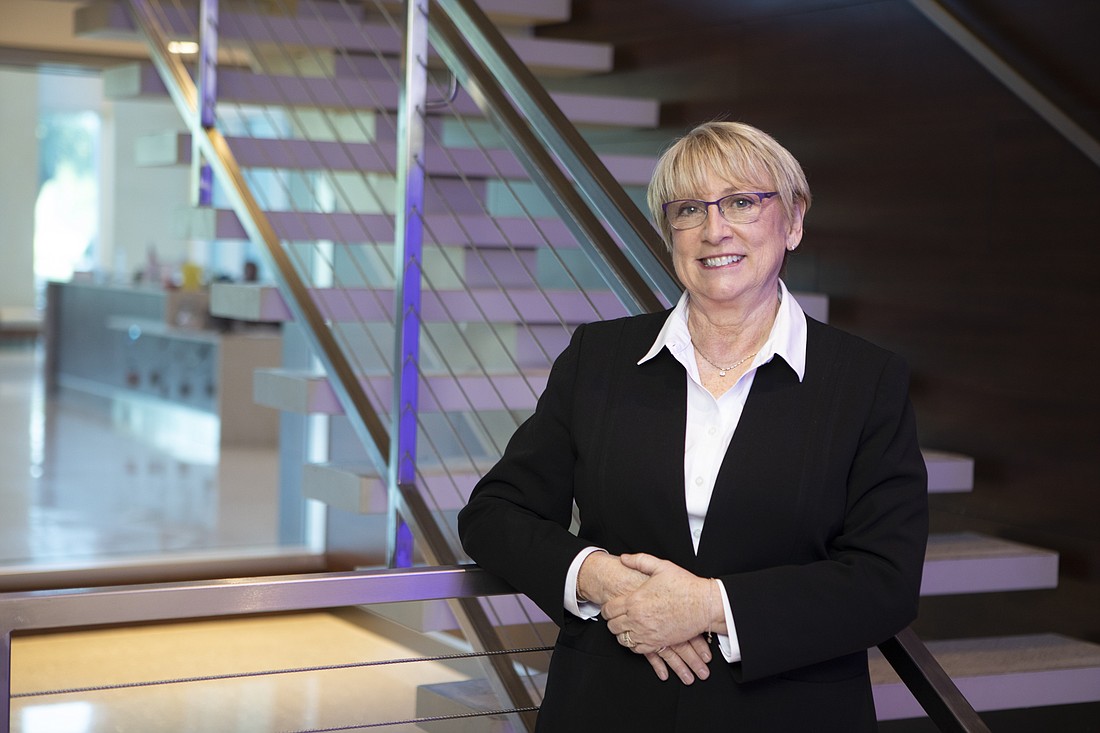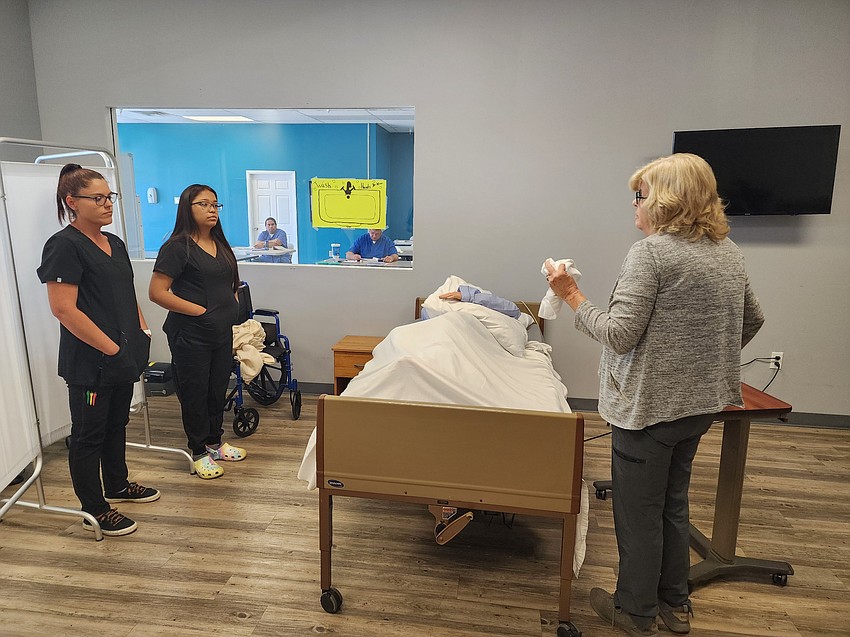- December 13, 2025
-
-
Loading

Loading

With a significant number of hospitals and health care systems popping up and expanding across the region, from Tampa to Naples, now is the not an ideal time to have a nursing shortage.
Yet while not novel, the shortage remains a perplexing issue for hospital leaders and administrators to solve in a sustainable way.
“We’ve had a nursing shortage for a while,” Lisa Baumgardner, associate chief nursing officer at Sarasota Memorial Health, says. “It’s not new, but we’re really feeling the effects of it now with (population) growth on top of that.”
That population growth is seen nearly everywhere, from roads and restaurants to schools and even some shopping centers. Overall, just between 2021 and 2022, Florida’s population grew 1.9% to 22,244,823, according to U.S. Census Bureau.
Lisa Johnson, BayCare Health System chief nursing executive, agrees, that the shortage stems from a greater volume of patients. The industry is also seeing more nurses, many of them baby boomers, retire than there are new nurses to fill roles — a demographic labor challenge hitting multiple other sectors, from insurance to auto sales to manufacturing.
“It’s really just trying to find that balance of inspiring people to go into nursing, supporting them as they go through school and (helping) launch their careers into an environment that meets their career goals and aligns with their values,” Johnson says.
Baumgardner says an increase in hospital admissions and COVID-19 also played a role. It led to early retirement for some with others grappling with fatigue and burnout. She says a number of nurses left the industry for good.
The U.S. Bureau of Labor Statistics predicts that between 2020 and 2030, over 275,000 nurses will be needed to fill roles. Job opportunities are expected to grow at 9% — which the bureau says is faster than all other occupations between 2016 and 2026. The BLS also predicts that each year through 2031, 203,200 job openings will become available in the nursing field.
On Sarasota Memorial Health Care System’s website, a search for open positions with the word “nurse” in the title returns 356 jobs. For Lee Health in Fort Myers it's 471 openings. At Lakeland Regional Health it's 166, while at Tampa General Hospital, there are 329 openings. Finally, at BayCare, there are 1,267 registered nurse positions open. BayCare covers Pinellas, Hillsborough, Pasco and Polk counties.
Tony Braswell, president and founder of Gale Healthcare Solutions, a Tampa-based company that created an on-demand service to address nursing shortages, brings a different perspective to the situation. He says the shortage has been around for as long as he’s been in the industry — 30 years — and now, with more flexible career options available, the gig economy, which includes side hustles and freelance work, may be to blame. “These nurses now have the opportunity to work in more places,” he says.
Braswell says health care systems need to adapt to the current workforce that has options like remote work and the gig economy. Instead of needing a nurse to work 9 a.m. to 5 p.m. Monday through Friday, Braswell suggests creating a more flexible work schedule. Many hospitals, of course, with 12 hour shifts and other options, offer some of that already.
“A nurse can’t work remotely,” he says, “but (they) can work flexibly.”
Most health care systems in the area aren’t sitting by as the nursing shortage continues.
BayCare, in particular, has several programs in place to help recruit and retain nurses. One allows nurses to move up depending on their career goals. It ensures that once a nurse is at BayCare, they don’t have to leave to pursue upward mobility in their careers, which Johnson says is the structure for some other health care systems. Instead, BayCare nurses go through an internship specific to the position. Through classwork and clinical rounds, the nurses are eventually able to move into that elevated role.

Johnson adds that BayCare visits high schools and sometimes middle schools to inspire students to go into the industry, even offering an “Earn as You Learn” program where BayCare pays for books, tuition and offers scholarships.
With roughly 30,000 team members/employees, BayCare also makes sure to anticipate current needs in the workforce.
“As you can imagine, they can go anywhere they want right now,” she says. To entice students to stay local, she adds that they offer flexible schedules and tuition reimbursement.
Sarasota Memorial, meanwhile, a community nonprofit hospital with 901 beds, has been hyper-focused on providing health and wellness benefits for employees, like yoga and therapy with pets. Baumgardner says they’ve had to become more clever with recruitment and retention efforts.
“We really prefer to hire within our community,” she says, “but with the growth we have experienced, we’re not able to fulfill all of our clinical needs here locally so we’ve had to do more advertising at a farther reach.”
SMH has also stepped up collaboration efforts with local high schools, specifically at the Venice High School Medical Academy, where SMH provides clinical experience, education and opportunities to learn various roles within a hospital to students. Additionally, the system has a summer student work program that allows students to spend part of their summer vacation working at the hospital. It also expanded a CareerEdge partnership to train certified nursing assistants at SunCoast Technical College.
On the school side of the shortage, Jamie Smith, State College of Florida associate vice president for communications and government relations, offers another solution. Her idea? Funding existing institutions that can "provide nurses and graduate them affordably and fast."
The Bradenton-based college’s nursing program recently expanded to allow 350 students to enroll. But the program relies on recurring funding to exist and expand.

Another education entity, Premier Nursing Academy, with locations in Pinellas Park and Bradenton, offers a six-week CNA training program that’s free to students. Working with several health care systems, the academy helps place students in jobs upon graduation — the formula is reliant on it as employers pay the cost of training, which is $2,750. The student then works in a certified nursing assistant role for a specified time afterward for their new employer.
Since the program is reliant on employers, so far, every student has graduated with a job. Gale Healthcare Foundation, a nonprofit tied to Gale Healthcare Solutions, recently donated $10,000 to the program.
"I'm not seeing any (solutions)," Braswell says of the shortage. "That's why we donated the money to Premier — because they're trying.
"It's going to get a lot worse," he says, "before it gets better."
Despite the nursing shortage, health care systems in the area continue to grow.
“We really don’t have a choice,” Baumgardner says. “There is a huge growth in our area that we’re running to keep up with.”
The SMH Venice campus in south Sarasota County, which recently opened, became full after a month of opening.
And, at least for the moment, BayCare figured out a solution that seems to be working, by dipping into the entrepreneur's playbook: be nimble. The organization, Johnson says, has a pool of over 1,000 nurses that get assigned each day to whichever hospital has the greatest need; typically it’s dependent on if a nurse falls ill or there’s been a surge in patient volume.
The pool nurses have a consistent number of patients they’ll tend to each day, the only change is where they’ll be working. It’s been a helpful recruitment source as nurses can work the pool for a few months to determine which hospital they want to work at long term.
Chris Palevich, president of Premier Nursing Academy, which has a facility in both Bradenton and Pinellas Park, looks at the situation from a volume standpoint, too —volume of nurses. "We have to create more staff," he says.
Rather than create a new campus, because he adds that it's "quite expensive to open a campus," he's instead working on developing an online platform to expand his reach across Florida. He expects that to be running in a matter of months.
He says, “This is the way we’re going to come back from a nursing shortage.”
This story was updated to reflect Lisa Johnson's correct title at BayCare.